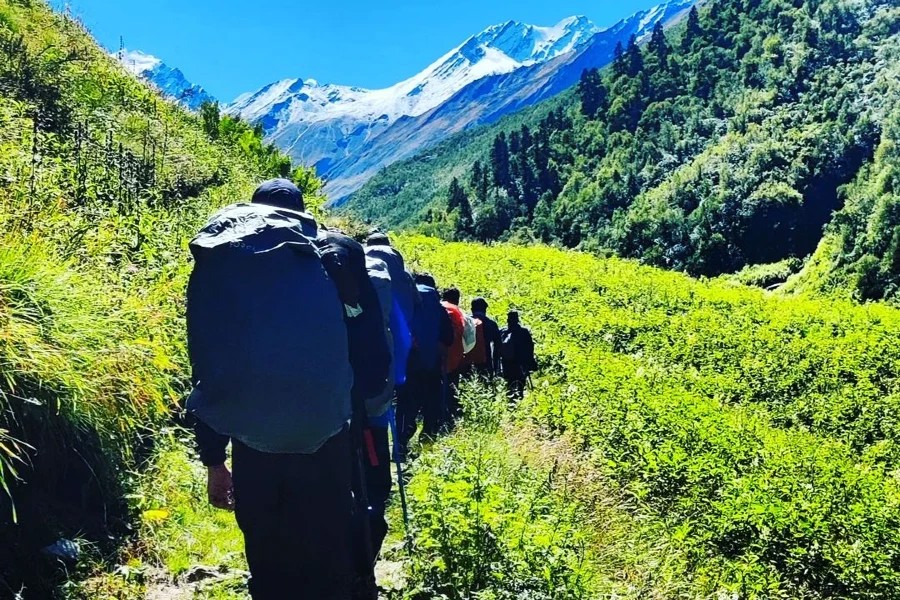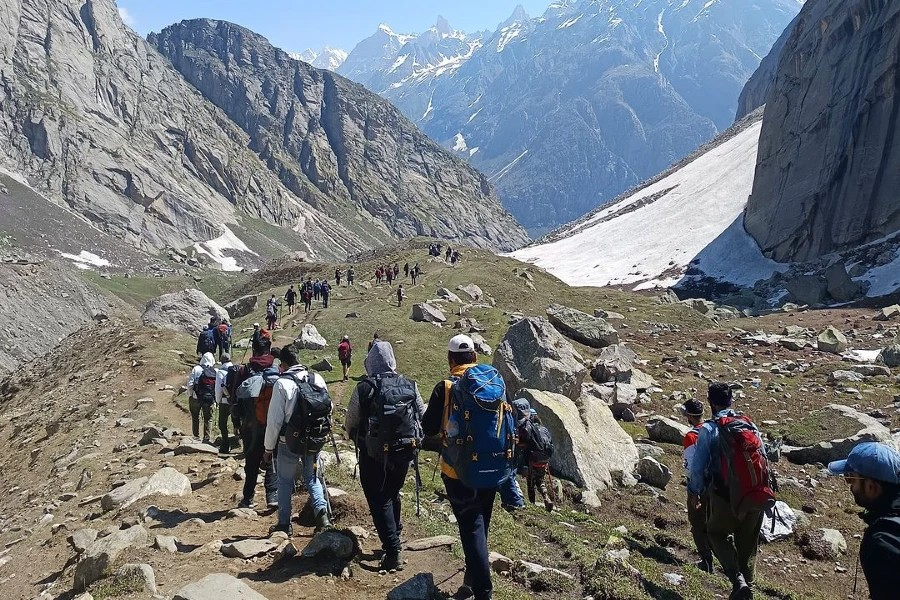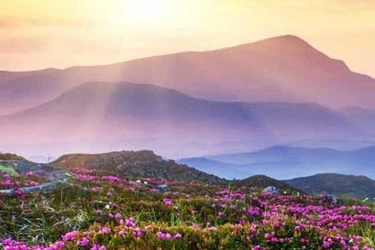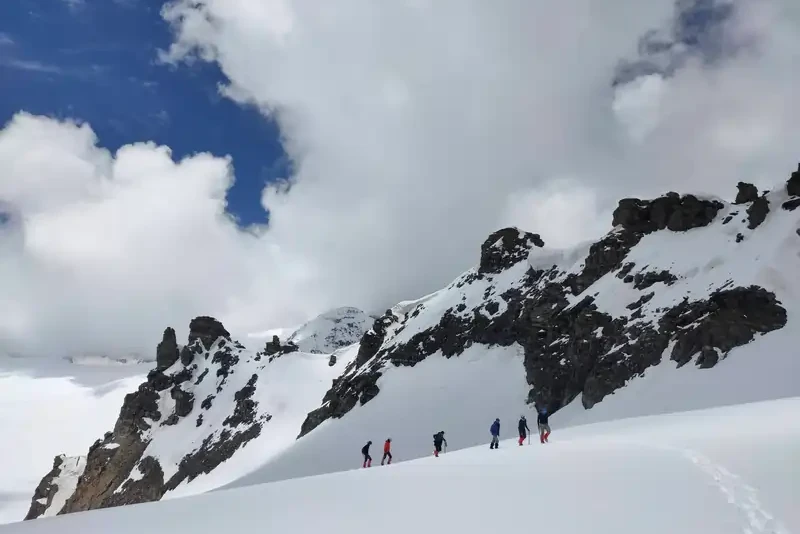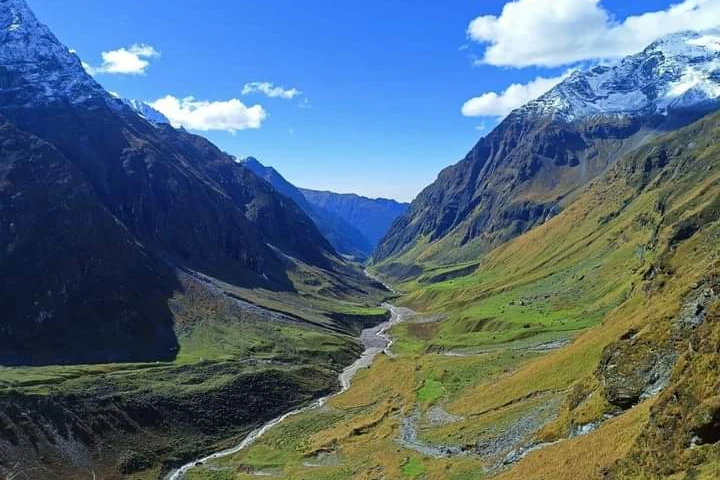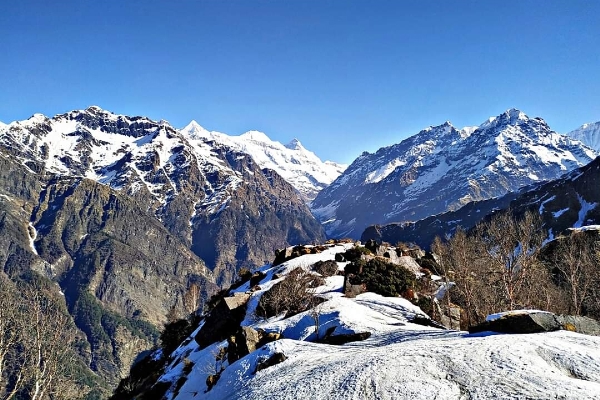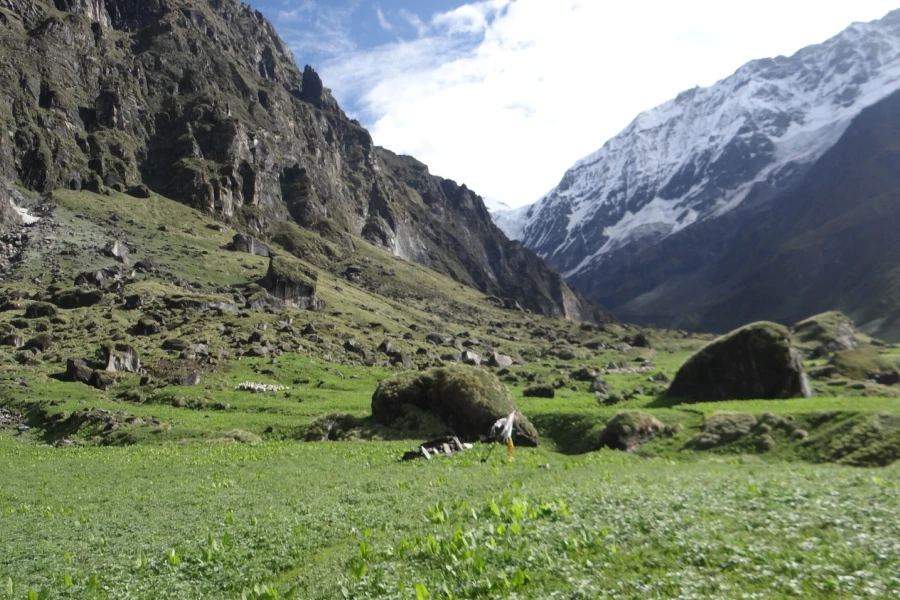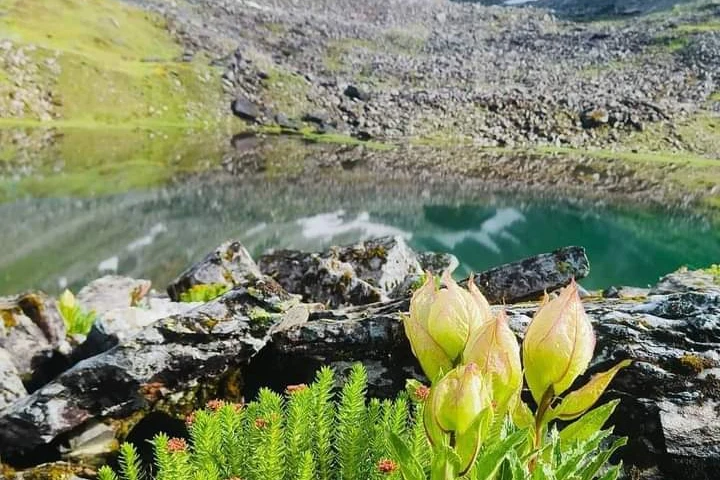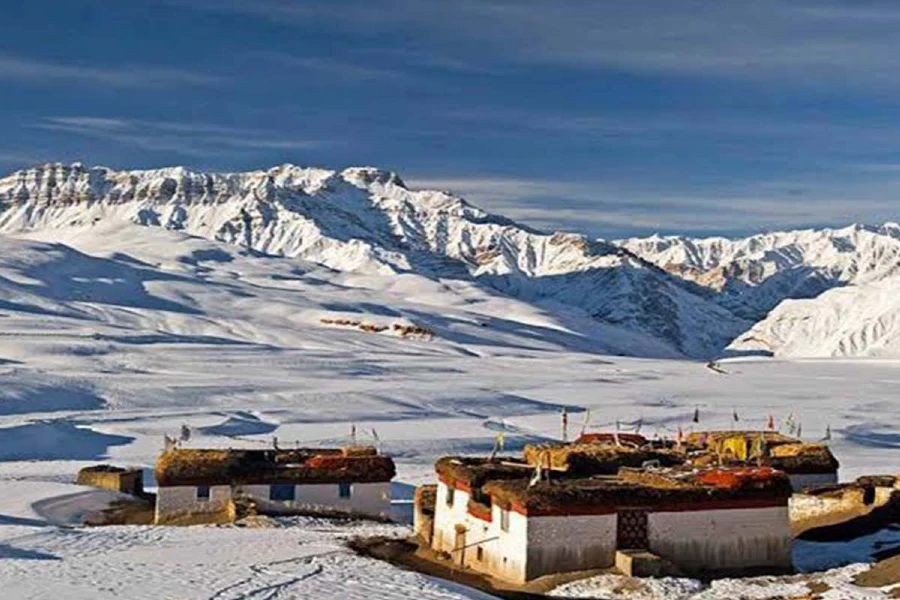
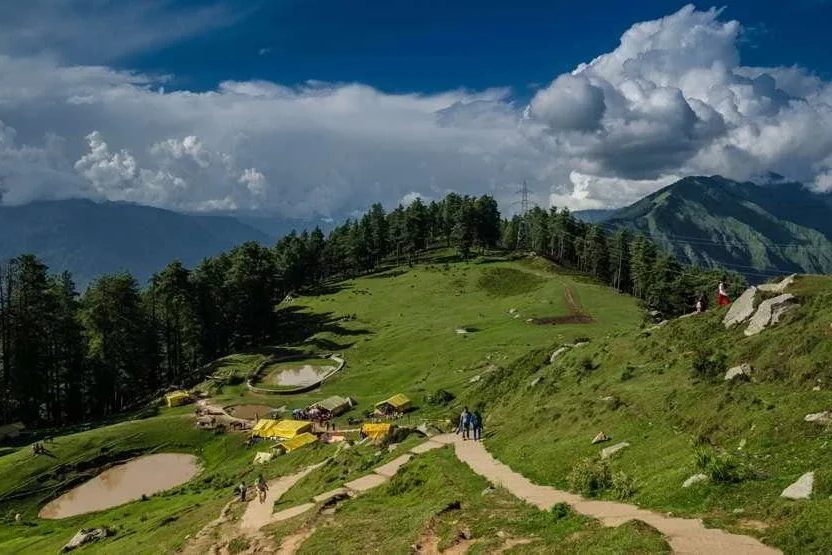

Images
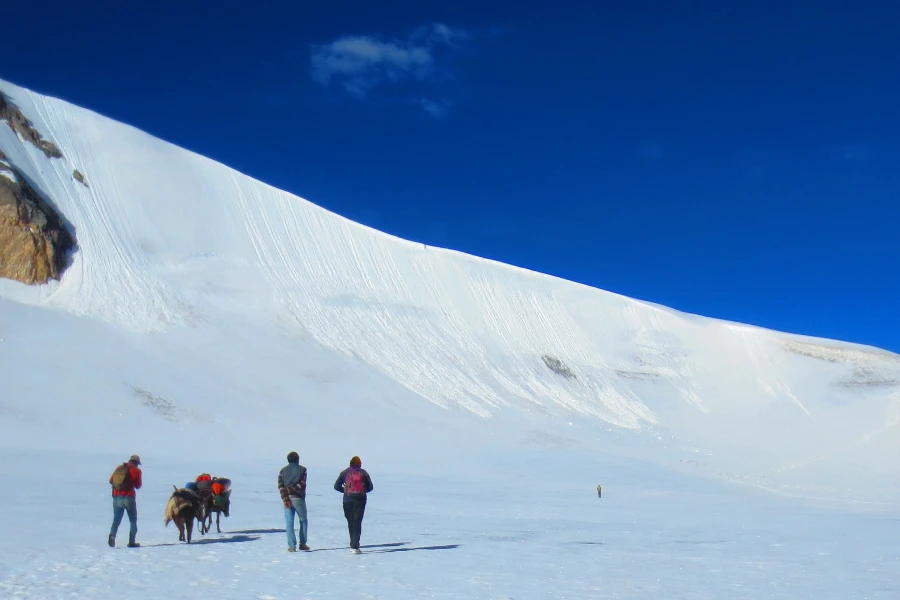
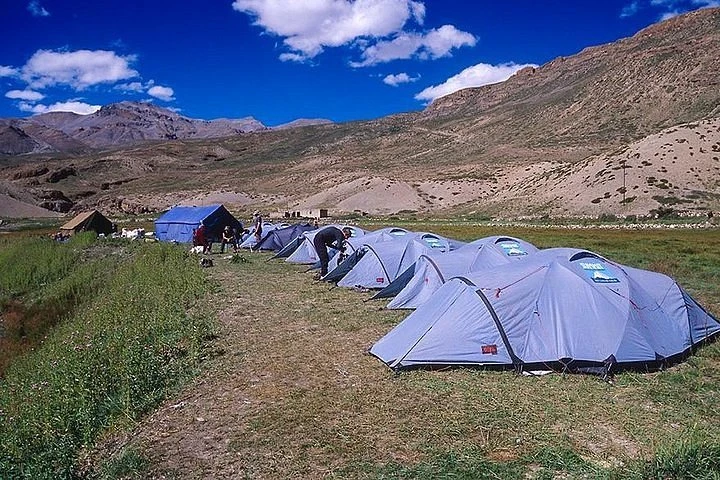
Images
Spiti, Himachal Pradesh
4.7 / 5 (71 Reviews)
Parang La Trek
Duration
12D / 11N
Tour Category
Himalayan Treks
Min Age
18+
Tax
No Hidden Charges
Starting from INR 59998
INR 41999
30% Off
Per Person
( Inclusive of all taxes )

Meal

Permit

Trekking

Guide

Tea Snacks

Transport

Tent Stay

Dormitory Stay

Meal

Permit

Trekking

Guide

Tea Snacks

Transport

Tent Stay

Dormitory Stay
Parang la Trek: Highlights
Trek through the stunning Spiti Valley and Ladakh, experiencing remote landscapes and challenging terrain.
Conquer the Parang La Pass at an altitude of 5,320 meters, offering unmatched panoramic mountain views.
Enjoy breathtaking views of snow-covered peaks and high-altitude deserts during this unforgettable trek.
Explore the vast, barren valleys and Tibetan plateau, a unique landscape not often seen by trekkers.
Pass through picturesque villages, remote monasteries, and traditional high-altitude settlements.
Encounter rugged, untouched wilderness and wildlife, making it a rewarding adventure for seasoned trekkers.
Immerse yourself in the unique culture and traditions of the Spiti Valley and Ladakh region along the trek.
Challenge your endurance on one of India’s toughest treks while enjoying awe-inspiring, serene landscapes.
Parang la Trek: Overview
Activity location: Spiti, Himachal Pradesh
Trip Duration: 8 Days | 7 Nights
Best Time to Visit: July to Sep
Trekking Distance: 120-130 Km Trek
Max. Altitude: 8,370 feet (5,600 meters)
Parang la trek Difficulty: Hard to Challenging
Meals: Vegetarian meals
Accommodation: Camping Tent (Triple/Quad Sharing)
About Parang la Trek, Uttarakhand:
The Parang La Trek is an exhilarating and challenging journey that takes trekkers through some of the most remote and stunning landscapes in India. Located at an altitude of 5,320 meters in the Spiti Valley of Himachal Pradesh, this trek connects Spiti with Ladakh. Known for its breathtaking views of snow-capped peaks, vast barren landscapes, and high-altitude desert terrains, the Parang La Pass trek offers an unforgettable adventure for seasoned trekkers seeking a challenging experience. The trek usually spans 7 to 9 days, covering approximately 75 kilometres of rugged terrain, and culminates at the Parang La Pass, a place that rewards trekkers with panoramic views of the Tibetan plateau.
The trek begins in the quaint village of Kaza in Spiti Valley, and from there, it winds its way through picturesque landscapes, remote monasteries, and pastures inhabited by nomadic herders. The Parang La Pass trek is considered one of the most difficult treks in India due to its tough ascents, unpredictable weather, and lack of proper infrastructure. Trekkers need to be physically fit and mentally prepared for the altitude and terrain challenges. However, those who complete the trek are rewarded with not only incredible natural beauty but also a deep sense of accomplishment. The Parang La Pass itself offers a rare opportunity to explore a relatively untouched region, making it a must-do for adventure lovers and experienced trekkers. Experience divine serenity on the Do Dham Yatra to Kedarnath and Badrinath, blending spiritual devotion, sacred temples, and majestic mountain journeys into a once-in-a-lifetime pilgrimage.
This Package Includes:
Transportation from Kaza
Trekking
Experienced & Certified trek leader and local support staff
First Aid
All Meals
Accommodation
All Permits And Passes Wherever Required
Excludes:
Trekking Gear Personal equipment
Any additional activities or services not included in the itinerary
Meal During Road Journey
Potters Or Mule To Carry Personal Luggage
Anything not mentioned in the includes
Trending Packages: Tungnath Chopta Trek | Kedartal Trek |Swargarohini Trek |Phulara Ridge Trek |Fachu Kandi Pass Trek
Tour Plan
Day 1
Arrival in Manali & Prep for Kaza
Arrival in Kaza from Manali (202 Kms driving distance)
It is recommended to arrive in Manali a day before departure to Kaza for proper preparation.
Use the day to fine-tune your packing list and purchase any necessary items for the trek.
Manali will be the last major town where you can buy essentials before heading into remote regions.
Spend at least one night in Manali for proper acclimatization to the high altitude.
Day 2
Acclimatization & Exploration in Chicham
Rest & Acclimatization Day at Chicham (18 Kms driving distance)
Start with a small hill walk in the morning for light physical activity.
After breakfast, take a walk along the Spiti river bank to stay physically active.
Visit the local Key monasteries and gompa in the afternoon for cultural exposure.
Head to Chicham village via the famous trolley bridge, offering scenic views of the valley.
Overnight stay in a homestay in Chicham, located at an altitude of 4270 meters.
Chicham is the starting point of the trek, ensuring a good acclimatization experience.
Day 3
Acclimatization & Exploration in Chicham
Rest & Acclimatization Day at Chicham
Continue with acclimatization to adjust to the high altitude of 4270 meters.
Take a short walk around Chicham village to stay active and explore the surroundings.
Enjoy the serene views of the Spiti Valley and interact with locals to learn about their culture.
Optional visit to nearby areas or relax and rest for the upcoming trek days.
Ensure proper hydration and light meals to help with the acclimatization process.
Day 4
Trek from Chicham to Thaltak
Chicham to Thaltak (Altitude: 4270 M to 4693 M, Distance Covered: 8 KM)
Start the trek on a well-paved metallic road, leading you out of Chicham village with minimal ascent.
After 45 minutes, you’ll see the Dumla campsite in the valley below on the right, ideal for those starting from Kibber.
Dumla campsite is at an altitude of 3890 meters, with a stream running through the middle and agricultural fields on either side.
The real test of stamina begins after Dumla, with a steep ascent for the next 3 hours, offering views of the typical Spiti mountains.
The trail consists of loose soil and gravel, with sparse vegetation, mainly Thama grass or bushes along the way.
The steep ascent is followed by a zig-zag dusty flat trail, revealing more expansive views of the surrounding mountain ranges.
As you approach Thaltak, Kanamo Peak becomes visible on the right, surrounded by barren, snow-free mountains post-monsoon.
Day 5
Trek from Thaltak to Bongrojen
Thaltak to Bongrojen (Altitude: 5050 M, Trek Duration: 6-7 Hours)
Begin the day with a descent into the Paralungbi Gorge, followed by an upstream hike.
Cross a river during the hike, which adds an extra challenge to the day.
Climb up through a rocky trail to reach the Bongrojen campsite at an altitude of 5050 meters.
The day is long and strenuous, requiring stamina and careful navigation of rocky terrain.
Overnight stay in tents at the Bongrojen campsite, resting for the next leg of the trek.
Day 6
Acclimatization & Rest at Bongrojen
Bongrojen – Rest/Acclimatization Day
Spend the day resting for better acclimatization to the high altitude.
Give your legs some rest before the challenging ascent to the pass.
Option for exploratory hikes around the campsite to stay active and enjoy the surroundings.
Overnight stay in tents at Bongrojen, preparing for the upcoming trek challenges.
Day 7
Cross Parang La & Trek to Dak Karzong
Bongrojen to Parang La (5490 M) to Dak Karzong (4850 M, Trek Duration: 5-6 Hours)
Begin early for the challenging ascent to Parang La, which takes about 2-3 hours.
Reach the Parang La Pass at 5490 meters, offering spectacular views of both the Spiti and Changthang valleys.
The pass provides views of the steep, rocky Spiti landscape leading to the open Pare Chu landscapes.
Continue trekking for about 3 more hours after the pass to reach the Dak Karzong campsite.
Overnight stay in tents at Dak Karzong, resting after a long day of trekking.
Day 8
Trek from Dak Karzong to Datang Yongma
Dak Karzong to Datang Yongma (4650 M, Trek Duration: 3-4 Hours)
Start the day by descending along the open plains of the Pare Chu River.
Enjoy scenic views of the vast, open landscapes as you trek towards Datang Yongma.
Reach the campsite at Datang Yongma, located at an altitude of 4650 meters.
Overnight stay in tents at Datang Yongma, relaxing after the day’s descent.
Day 9
Trek from Datang Yongma to Chumik Shilde
Datang Yongma to Chumik Shilde (4330 M, Trek Duration: 6-7 Hours)
Continue trekking alongside the Pare Chu River, enjoying the tranquil surroundings.
Cross the Racholamo and Norbu Sumdo areas during the trek.
Reach the campsite at Chumik Shilde, located at an altitude of 4330 meters.
Overnight stay in tents at Chumik Shilde, resting after a long and scenic day of trekking.
Day 10
Trek from Chumik Shilde to Kiangdom
Chumik Shilde to Kiangdom (4450 M, Trek Duration: 3-4 Hours)
Trek across the plains, heading towards Kiangdom, located at the southern edge of Tso Moriri Lake.
Kiangdom gets its name from the Kiangs (wild Tibetan asses) that graze in the area.
This region is a birdwatcher’s paradise, with abundant wildlife and stunning views.
Overnight stay in tents at Kiangdom, enjoying the peaceful surroundings near Tso Moriri.
Day 11
Trek from Kiangdom to Korzok
Kiangdom to Korzok (4500 M, Trek Duration: 6-7 Hours)
Enjoy a beautiful, long trek along the shores of Tso Moriri Lake, with stunning views of the lake.
The majestic Lungser Kangri (6666 M) provides a scenic backdrop throughout the walk.
Visit the ancient monastery in the village of Korzok, adding a cultural touch to the day.
Celebrate the completion of the trek with a small party in the evening.
Overnight stay in tents at Korzok, marking the final night of the trek.
Day 12
Drive from Korzok to Leh
Korzok to Leh (3500 M, Drive: 213 Kms/7 Hours)
After breakfast, begin the drive to Leh, enjoying the scenic journey through the rugged landscapes.
The drive will take approximately 7 hours, offering beautiful views of the region.
This marks the end of the trek, with the completion of your adventurous journey.
Upon arrival in Leh, the trip officially concludes.
Select Package Options
Parang la Trek With Transportation
INR 41999
59998
( Inclusive of all taxes )
Per Person
No Bookings Available! Make Enquiry
Show Details
Age Policy:
This event is suitable for anyone above 18 years of age, prices will be the same as an adult.
Price Includes
Tent Stay
Meals
All Days meals
Permits
Event Permits are provided.
Government permit
Guide
Professional leader to assist you
Notes:
For 10-15 people: 1 Trek Leader
For 25-30 people: 2 Trek Leader
Activities
Trekking
Transfers
Non-A/C Shared Vehicle
Pickup Points
Kaza
Dropping Points
Kaza
Things to Carry
Clothing
Trekking Shoes: Sturdy, waterproof hiking boots with good grip.
Warm Clothing: Thermal layers, fleece jackets, and a waterproof jacket.
Trekking Pants: Quick-dry pants or cargo pants.
T-shirts: Moisture-wicking T-shirts for comfort.
Warm Hat and Gloves: For protection against cold.
Socks: Wool or synthetic hiking socks (avoid cotton).
Trekking Gear
Backpack: Comfortable daypack to carry essentials.
Trekking Poles: Helpful for stability on steep trails.
Rain Cover: For your backpack in case of rain.
Hydration
Water Bottles: Reusable water bottles or hydration bladder.
Water Purification Tablets: For treating water from streams.
Health and Safety
First Aid Kit: Basic first aid supplies, including antiseptics and band-aids.
Personal Medications: Any prescription medications you require.
Sunscreen: High SPF to protect against UV rays.
Lip Balm: With SPF protection.
Miscellaneous
Camera: To capture the stunning landscapes.
Multi-tool/Swiss Army Knife: For various uses.
Headlamp/Flashlight: With extra batteries for nighttime.
Toiletries: Biodegradable soap, toothbrush, toothpaste, toilet paper.
Trash Bags: To carry back any waste.
Starting from INR 59998
INR 41999
30% Off
Per Person
( Inclusive of all taxes )
Enquiry Form
We assure the privacy of your contact data.
This data will only be used by our team to contact you and no other purposes.
Why escape2explore
Verified Google Reviews
4000+ Reviews on the google platform.
500+ Tours and Activities
We have activities across every category so that you never miss best things to do anywhere.
Customer Delight
We are always able to support you so that you have a hassle free experience.
Reviews (71)
4.7
Out of 5.0
5
55
4
13
3
3
2
0
1
0

Jattin Mehra
Reviewed: Nov 8, 2024
5/5
Parang La is now my favorite trail. Tent Stay provided by escape2explore made it magical. About food – warm meals boosted morale. Our guide was supportive, and Transportation was smooth... Read More

Prateek Chauhan
Reviewed: Dec 18, 2024
5/5
One of my favorite treks ever! The Tent Stay at night was peaceful and scenic. escape2explore’s guide made us feel safe throughout. About food – perfectly portioned and delicious. Loved... Read More

Nelima Das
Reviewed: Dec 6, 2024
5/5
n outstanding trek! Dormitory Stay was a great place to rest. About food – exceeded expectations. The guide was a true motivator. escape2explore made Transportation totally hassle-free I had an... Read More

Bhavna Singh
Reviewed: Dec 4, 2024
5/5
What a breathtaking experience! The Tent Stay provided by escape2explore was cozy. About food – kept us fueled and content. The guide was fun and informative. Transportation was perfectly arranged.the... Read More

Charu Desai
Reviewed: Jul 27, 2024
5/5
Our Tent Stay in the Himalayas was unforgettable. The guide from escape2explore was well-prepared. About food – satisfying and fresh. Great transportation arrangements as wel; The Parang La Trek gave me... Read More
Related Packages
Frequently Asked Questions
Q1 : Where is Parang La Trek located?
Parang La Trek is a high-altitude trail that connects Spiti Valley in Himachal Pradesh to Ladakh. It crosses the Parang La Pass (5,580m), offering stunning landscapes and remote wilderness.
Q2 : How difficult is the Parang La Trek?
This trek is rated challenging due to its high altitude, extreme weather conditions, glacier crossings, and long trekking days. It requires good physical fitness and prior high-altitude trekking experience.
Q3 : What is the best time to do the Parang La Trek?
The ideal time is between July and September, when the snow has melted, and the trails are accessible. During this period, the weather is relatively stable, with clear skies and breathtaking views.
Q4 : Do I need prior trekking experience for this trek?
Yes, this trek is not for beginners. You should have completed at least one or two high-altitude treks above 4,500m before attempting Parang La. Strong endurance and acclimatization are crucial.
Q5 : How long does the Parang La Trek take?
The trek typically takes 10–12 days, depending on the itinerary. It includes travel time, acclimatization days, and trekking from Kaza (Spiti) to Korzok (Ladakh) via Parang La Pass.
6. What kind of terrain can I expect on this trek?
Q6 : What kind of terrain can I expect on this trek?
The terrain varies from lush valleys to rocky trails, steep ascents, river crossings, glacier walks, and high-altitude deserts. The trek also passes through Changthang Plateau, famous for its vast wilderness.
Q7 : How do I prepare physically for the Parang La Trek?
Regular cardio exercises like running, cycling, and swimming help build stamina. Strength training and hiking with a weighted backpack are essential to prepare for long trekking days at high altitude.
Q8 : What permits are required for the Parang La Trek?
Trekkers need an Inner Line Permit (ILP) for Ladakh and Spiti Valley. Foreign nationals require special permission to access restricted areas. Trek organizers usually arrange all permits.
Q9 : What is the highest altitude on this trek?
The Parang La Pass is the highest point at 5,580 meters (18,307 feet). The trail also crosses multiple high-altitude campsites, requiring careful acclimatization.
Q10 : What kind of accommodation is available during the trek?
Trekkers stay in tents at high-altitude campsites. Some villages on the route may offer basic homestays, but most of the trek is in remote regions where only camping is possible.
Q11 : What are the biggest challenges on this trek?
The toughest challenges include altitude sickness, harsh weather, river crossings, long trekking hours, and isolation. Mental resilience and proper acclimatization are key to overcoming these difficulties.
Q12 : I am a solo traveller, can I join the Parang La Trek?
Yes, you can join the trek to Parang La. The trek’s difficulty level is moderate and can be attained without someone’s support. Wear robust footwear, and comfortable clothes, and maintain basic fitness to complete the trek.
Q13 : Parang La Trek is safe for females?
The safety and security of women/girls are paramount to us. Hence, it's entirely safe for women/girls to participate in our treks and travels. Our trek leaders always accompany the group, offering constant assistance and direction. Our campsites are thoroughly secure and provide a safe lodging environment. In addition, our female trek leaders often join our treks.
Q14 : What will happen if the Parang La Trek does not go through?
Your money will be refunded within 2-3 business days.
Q15 : Can I reschedule my Parang La Trek to a future date if I am unable to attend on the day of departure?
Unfortunately, it's not feasible to reschedule your trek to a future date if you're unable to attend on the designated day, regardless of the circumstances (like family emergencies, health problems, or work commitments). However, if you have concerns about this policy, please don't hesitate to email us at info@escape2explore.com, and our team will get in touch with you to discuss further.
Cancellation Policy
Life is unpredictable and we understand that sometimes you have to cancel or change your trip dates and we endeavour to make it as easy as possible for you. However, please understand that we plan everything including guide fees, permits, accommodation and rations in advance. Therefore, any cancellation means inconvenience and certain losses to the people involved in various stages of the programme. Keeping that in mind, our cancellation charges are as below -
Cancellations before 30 days from the start of the event: Get a monetary refund with 15% of cancellation charges.
Cancellations between 30 days and 15 days to the start of the event: 50 %refund.
Cancellations less than 15 days to the start of the event: No refund.
Cancellations will be accepted only by email.
Note: The Himalayan Daredevils reserves the right to cancel a program before departure in the event of logistical problems arising due to natural calamities, strikes, wars or any other circumstances that make the event inadvisable. In this case, we will refund 50% of the event fees.
Itinerary Changes &Trip delays:
We plan itineraries based on the information available at the time of planning and in rare circumstances, they are subject to change. If the itinerary is changed or delayed due to unforeseen circumstances such as bad weather, transportation delays, government intervention, landslides etc., we will always aim to give you the best experience possible. However, The Himalayan Daredevils not be held responsible for the cost of delay or changes.
For Bookings made from Third Party Websites:
The client is responsible for communicating with a third party (booking website) for cancellation.
Cancellation / Refund is done by a third party based on their policies.
Blog - Parang La Trek: A Quick Guide
The Parang La Trek is one of the most exhilarating high-altitude treks in the Indian mountains. It links the cold Spiti in Himachal Pradesh to the lovely Ladakh in Jammu and Kashmir. At approximately 5,600 meters high, Parang La is a significant mountain pass that was once used for trade between the Spiti people and the Changthang nomads in Ladakh. This trek takes you on a wild trip over big ice fields, empty valleys, tall mountain paths, and river walks. It provides a true and unforgettable mountain thrill. The walk begins in Kibber, a high village in Spiti, and ends at Korzok by the Tso Moriri Lake in Ladakh. This trek stands out for its amazing change in view from the rocky cuts and deep cuts of Spiti to the wide green fields and blue high lakes of Ladakh. The way goes through deep cuts of the Parilungbi River, ice parts of the Parang Glacier, and ends at the beautiful Tso Moriri Lake with its snowy tops and grazing fields.
The Parang La Trek is really hard and tests your body. It covers over 100 kilometres and takes about 10-12 days to finish. The path has no homes or tea places, so you must bring your camp and stuff. You have to get used to the height, alone, feel, and hard weather. You need to have done high walks before and be very strong in your head. For walkers and photo takers, this trek offers unmatched views of the wide mountain sights, the big wild, and a deep, alone feel. You might see wild blue sheep, big ground squirrels, and even snow big cats, which makes the trip even more exciting. The trek also has deep old meaning, as it follows old trade and travel ways used by traders, monks, and herders for many, many years. In short, Parang La is more than a trek; it's a dive into the deep mountains, far from the usual tourist paths. It is a trip for your body and soul through some of the wildest and untouched places in India, making it a must-do for serious walkers and adventure lovers.
History of Parang La Trek

The Parang La Trek has a long story and a big old cultural meaning. Set high in the mountains, Parang La was once a path for trade and pilgrim walks, connecting Spiti Valley in Himachal Pradesh to the Changthang land of Ladakh in Jammu and Kashmir. For a long time, it was more than just a mountain path it was a main way for the trade of goods, culture, and holy know-how across lands split by tough land and hard weather. In history, Parang La was key in the mountain trade used by the Spiti and Ladakh people, mainly traders and wandering herders. Groups carrying salt, wool, barley, and dry meat would go from the big Changthang plains of Ladakh to the rich valleys of Spiti and beyond. In turn, needfuls like grains, spices, and hand-crafts would be brought back. This trade not only kept up the local money but also made strong cultural links between the people of Ladakh and Spiti. The trek path also served as a holy way for Buddhist monks and travellers. Monks would take long trips across Parang La to go to linked holy places, take part in holy learning, or share teachings. These exchanges were key in keeping and spreading Tibetan Buddhism in the mountain area. With new ways to move and border changes after freedom, mainly due to being close to Tibet (China), this way of trade went down a lot. However, the story of the Parang La path stayed in the minds of the local people. Moves by the Changpa wanderers of Ladakh, who keep animals in these tough lands, kept parts of this old path alive. Even today, you can see old piles of stones and worn paths that show the long past of traders and monks.
In recent years, the way has become popular among strong walkers and searchers who want to walk the same paths as the old travellers. Unlike more common treks, Parang La keeps its wild, untouched nature, showing the hard times faced by those who once needed it for living and connection. The area's being away has also let it stay in good shape, on both natural and cultural sides. Ice streams, lands rich in old animals, old stone carvings, and local stories keep adding deep history to the walk across Parang La. New interest in the trek has also brought focus to keeping the old ways of knowing, path signs, and old ways used by earlier people. The story of Parang La is not just about the past; it's a living story that shows how people last, change, and live with nature at high altitudes. In the end, the story of the Parang La Trek is deep in the ways of trade, pilgrim walks, and living. It is a tale of lasting human spirit, cut into the hard land of the high mountains. Each step along this trek echoes the steps of many people who crossed mountains not just for a living or faith, but to link two far yet culturally and money-linked worlds.
Nearby Places Around Parang La Trek
Kibber Village: Kibber, where the Parang La Trek starts, is one of the top high towns you can reach by car in the world. It sits about 4,270 meters up. In the Spiti Valley, this little town is surrounded by dry hills and deep cuts. Kibber is not just known for its dream-like look but also for being close to the Kibber Wildlife Sanctuary. There, you can find snow leopards, blue sheep, and Himalayan ibex. It's good to get used to the high air before the trek and to see how the Spiti people build and live.
Key Monastery: A bit before Kibber, Key Monastery stands as one of the old and famous Buddhist spots in the Spiti Valley. Set up high, it looks down on the Spiti River. This place started in the 11th century and is key for learning Tibetan Buddhism. Walkers often stop here for blessings before they start out. Its halls, wall art, old writings, and monks' sounds make a calm and deep feel.
Tso Moriri Lake: Tso Moriri, where the Parang La Trek ends, is one of the top high lakes in India, at about 4,522 meters in Ladakh. With snow-topped tops and big green lands around, the lake brings birds from far, like the black-necked crane and bar-headed geese. It is a quiet spot for deep thought and rest after the hard trek. The nearby Korzok village offers a look at the Changpa people’s moving life.
Korzok Village: On the north edge of Tso Moriri Lake, Korzok is one of the highest homes in India. The Changpa nomads live here, known for moving with their livestock and pashmina goat. Korzok Monastery, by the lake, brings a deep feel to the town. Walkers coming to Korzok after the Parang La Trek find it a nice, rich place to rest, talk with people, and learn about Ladakh ways.
Chicham Bridge: Near Kibber, the Chicham Bridge is one of the top high bridges in Asia and a main stop for those going on the trek. Going over a deep cut, the bridge links Kibber and Chicham towns and gives a great, wide look of the Spiti world. It’s a wow in building and a top spot for photos before starting the journey to Parang La.
Spiti Valley: Before or after the Parang La Trek, seeing more of Spiti Valley is a must. Spots like Dhankar Monastery, Tabo Monastery, Pin Valley, and Langza offer cool things from old Buddhist ways to looking for fossils. The valley’s plain pretty look, with its high dry charm, makes it a must-see in the Indian Himalayas.
Best Times to Visit Parang La Trek
July to September: The best time for the Parang La Trek is from mid-July to mid-September. In these months, high spots in Spiti and Ladakh are mostly free of snow, making it easy and safe to walk. The sky is clear, showing great views of the high hills. Ice and rivers are okay, and while it’s still cold, it's not too bad. This time also keeps the path free from new snow, which happens before July or after September.
October to May: From October to May, the Parang La area is mostly hard to reach due to a lot of snow, bad weather, and very low temperatures. The passes and places around are full of snow, and most towns on the route, like Kibber and Korzok, get ready for a long, lonely winter. Walking is almost not doable and very risky during this time. Even local travel cuts down, and no help or saved work can be done.
Post-Monsoon (August): August, right after the rains, is a super time for the Parang La Trek as the skies clear and the land shows more colours. Green lands in Ladakh bloom, the streams and ice rivers are full, and Tso Moriri Lake shines even more in its blue look. Yet, walkers must still watch out for fast weather shifts and some landslides on the way to Kibber.
How to Reach Parang La Trek
Reach Kibber (Starting Point) via Manali: The trek starts at Kibber Village in Spiti, and you get there by going through Manali. Travel through the Atal Tunnel and move on to Kaza, the main town of Spiti. It takes about 10-12 hours to drive on rough roads. Kibber is just 18 km from Kaza, and you can get there by taxi. Most trekkers take this route to start their hike in Spiti.
By Road from Shimla (Alternative Route): You can also get to Kibber through Shimla. This way goes on the Hindustan-Tibet Highway and goes by places like Reckong Peo, Nako, and Tabo before reaching Kaza and Kibber. It takes 2-3 days by this road, but it helps to slowly get used to less air as you climb. The views are amazing and show another face of Spiti.
Reaching Korzok (Endpoint) from Tso Moriri: At the end of the trek, go down to Korzok Village by the Tso Moriri Lake in Ladakh. Leh, the closest big town, is about 220 km from there. The drive to Leh takes 7-9 hours. You can find taxis and shared rides from Korzok to Leh, but it is smart to book these in advance as choices are limited.
Why Book with escape2explore
When exploring the Parang La Trek and beyond, escape2explore stands out as a trusted name in adventure and experiential travel. Here’s why hundreds of travellers choose us for their getaways:
Trusted, Well-Reviewed Local Operator: escape2explore has gained the trust of thousands of content tourists all over India. With persistent positive feedback and an unblemished reputation for delivering quality experiences, we assure you that your experience will be hassle-free, memorable, and value-packed. Our insider local knowledge guarantees that you will always be in safe hands.
Seasoned Guides: Our trips are led by friendly, trained, and professional guides who are passionate about the outdoors and your safety. Whether it's a beach trek, a cultural tour, or a spiritual walk through temples, our team knows the terrain, the stories, and how to make each moment count.
Safe & Curated Itineraries: Your safety is our number one priority. Our tour packages are thoughtfully crafted with safety measures, researched accommodations, and easy travel arrangements. We take care of the details so you can have the experience hassle-free and worry-free.
Unique Experience That You Won't Find Anywhere Else: With escape2explore, you discover more than the tourist attractions. We go off the beaten track with hidden beaches, unusual treks, offbeat cultural destinations, and true interactions.

About Us
Unleash adventure near Bangalore! From hills to caves, immerse in nature's thrill. Unforgettable memories await!
Quick Links
Contact Us
1st floor, 318, 8th Main Rd, Remco Bhel Layout, Ideal Homes Twp, RR Nagar, Bangalore - 560098
